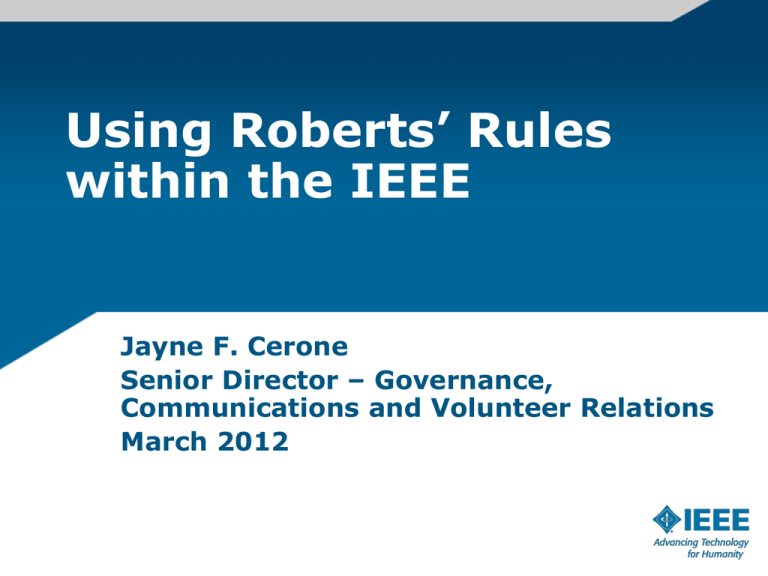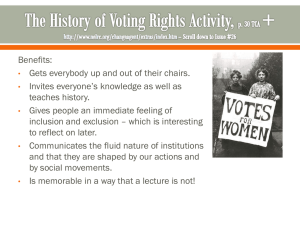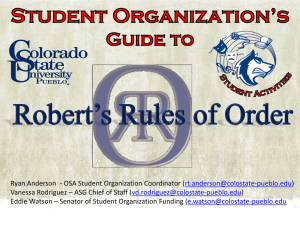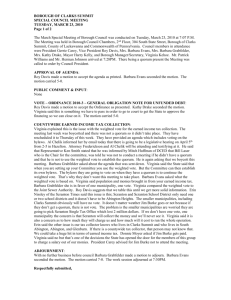Rules of the Majority
advertisement

Using Roberts’ Rules within the IEEE Jayne F. Cerone Senior Director – Governance, Communications and Volunteer Relations March 2012 The key building blocks of Roberts’ Rules Address one idea at a time Justice and courtesy for all Rule of the Majority Rights of the Minority Can be misused by mistake or deliberately 2 Address one idea at a time Follow the agenda One motion or discussion item per agenda item Finish discussion of one item before moving on If discussion moves away from the motion, chair responsible for refocusing the discussion 3 4/12/2015 Justice and Courtesy for All Chair recognizes one individual at a time; maintains order Speaker should be concise Chair may use time limits (per agenda) Comments are directed to the body (not to each other) May go pro/con with discussion 4 4/12/2015 Rules of the Majority: Rights of the Minority All members may speak Minority has right to be heard After a vote – move on Motion to Call the Question – Second – No debate – Majority vote 5 4/12/2015 Basics of running a meeting Call to order Approve agenda Approve minutes Action items (motions) Discussions New business/old business Adjourn – note time of next meeting, if known – a motion is not required if agenda done 6 4/12/2015 Responsibilities of the chair Responsible for creation of agenda Runs the meeting and his/her decisions carry (unless overturned by a vote of 2/3 of the body) One motion or discussion at a time May not call the question 7 4/12/2015 An Agenda List items Group by action, subject or speaker – Action/Discussion/Reports – Committee A/ Committee B – Speaker A/ Speaker B Place action items early (before members begin to leave) Put times – even if you do not adhere to them, it serves as a guide to keep meeting moving 8 4/12/2015 Consent Agenda Method for caring for routine business Post prior to the meeting Approve all motions at once (often at time of agenda approval) Any individual may remove an item No discussion at this time – place into regular agenda 9 4/12/2015 Quorum Usually half +1 of the voting members Can have special additional considerations – MGA requires that the quorum for the MGA Board must include at least a majority of the Region Directors. Establish quorum at the start of the meeting; if a quorum is not called, assume the quorum exists. 10 4/12/2015 Good management Keep meeting organized – If a motion on the table, complete that motion before moving on – Motion may be amended twice – after that best to start over There are ways to stop and start items 11 4/12/2015 Common actions: Postpone to a Certain Time “I move to postpone this item until [the next TAB meeting]” - Requires a second May be debated May be amended Requires majority vote IF APPROVED, the motion AUTOMATICALLY is added to the agenda – in this case at “the next OU meeting” 12 Common actions: Lay on the Table (or “Table”) “I move to table this item” - Requires a second - May not be debated - May not be amended - Requires majority vote IF APPROVED, the motion is “put aside” until someone makes a motion to remove it “from the table”. If not addressed by the close of the next meeting, it is “killed” automatically. 13 Common actions: Refer to Committee “I move to refer this item to [the TAB Periodicals Committee]” - Requires a second - May be debated - May be amended - Requires majority IF APPROVED, the motion is referred to the named committee. The committee is expected to bring it back at the next OU meeting 14 Common Misunderstandings about RRoO actions “Second” just means you want to debate – does not mean you must vote for the motion Postpone Indefinitely – Needs a Second – Debatable – Majority vote THIS WILL “KILL” THE MOTION 15 How many is a majority? A majority is “more than half” If 24 voting members, majority is 24/2 = 12, more than 12 is 13 If 25 voting members 25/2 = 12.5,more than 12.5 is 13 If 26 voting members 26/2 = 13, more than 13 is 16 14 But .. the denominator is the total number of those eligible to vote who are present at the time of the vote. So… If 24 voting members 13 vote yes 11 vote no 13/24 is > or equal to majority = PASS If 24 voting members 11 vote yes, 9 vote no, 4 abstain 11/24 is < majority = NOT PASS even though a majority of votes cast were yes 17 IEEE MEETINGS: WHAT IS UNIQUE? 18 4/12/2015 Governance: Conducting the Meeting “What are the Rules?” New York State (Certificate of Incorporation) IEEE Constitution IEEE Bylaws IEEE Policies/Finance Operations Manual/etc. Major Board Governing Documents – MGA and TA Operations Manuals OU Governing Documents – Bylaws/Charters/Policies/Manuals 19 Roberts’ Rules of Order (11th edition) – Primarily for Issues NOT CODIFIED in other Governing Documents Examples of things codified in other documents (RRoO does not apply) Bylaw I-300.4(1): “..the majority of the votes of the members present and entitled to vote, at the time of the vote, provided a quorum is present, shall be the act….”. Not “present and voting” TAB Operations Manual: Allowed to postpone or lay-on-the-table” until the next meeting, even though TAB meets only three times a year 20 Limitations of Governance Documents Use common sense There are not enough rules to address every possible issue When you try to write a rule for every circumstance, you end up with Too many rules Feeling that some rules are “not important” Confusion and mistrust Sometimes you need to make a decision that is unpopular/hard to do or makes some of the group unhappy. 21 Comments, Questions, Discussion? 22







